Second Hospitalization Unit, 30th Field Hospital Unit History

Cover of Booklet with the History of the Second Hospitalization Unit, 30th Field Hospital. This small book dedicated to the Unit was printed in Munich, Bavaria, by Knorr & Hirth, in 1945 and distributed to its members.
Introduction & Activation:
The 30th Field Hospital was activated at Camp Campbell, Hopkinsville, Kentucky (Armored Division Camp: acreage 102,414, troop capacity 2,422 Officers & 45,198 Enlisted Men –ed) on 17 September 1942. A cadre of 1 Officer and 25 Enlisted Men were sent from the Station Hospital, AAFSF, Jackson Army Air Base, Jackson, Mississippi, as the activating unit. Interesting to note is that three Field Hospitals were set up and activated around the same period and at the same place. Moreover, they would also serve in the Aleutian Islands Campaign:
28th Field Hospital > 16 September 1942
29th Field Hospital > 18 September 1942
30th Field Hospital > 17 September 1942
On 1 November 1942, Lt. Colonel Elmo R. Zumwalt, MC, arrived and assumed command from Station Hospital, Fort Lewis, Tacoma, Washington (Army Ground Forces Training Camp –ed). The unit’s strength was based on T/O 8-510 dated 28 February 1942 allowing for 17 Officers – 18 Nurses and 211 Enlisted Men.
A 10-week basic Training Program mainly based on MTP 8-1 (issued 18 February 1942, designated: Medical Department Mobilization Training Program for Medical Department Units at Unit Training Centers and Medical Department Replacements at Enlisted Replacement Centers covering a 13-week program –ed) and MTP 8-10 (issued 29 July 1942, designated Medical Department Mobilization Training Program for the Unit Training of Field Medical Units by the Services of Supply + Change C1 dated 21 October 1942, and C2 dated 13 March 1943 –ed) was begun as soon as possible, with the last program being destined for advanced training of numbered hospital units containing personnel that had already completed their Basic Training either under MTP 8-1 or at a Medical Replacement Training Center. Training equipment began to arrive and the subsequent Training Program stressed tent pitching (mainly heavy such as ward tents), convoy driving under all conditions, including blackout, close order drill and marches and hikes. Bivouacs were also started in February 1943. The focus was placed on sanitary installations and camp sites were selected with the purpose of obtaining all types of terrain with or without natural camouflage. All food was prepared in the bivouac area and the men learned how to live in the field as efficiently as possible. Thereafter bivouacking became a part of the general training schedule, emphasizing medical service and support in the field.

New Year’s Eve & New Year’s Day 1944. 30th Field Hospital staff and personnel celebrated New Year under tentage in Zephyr Valley, overlooking Trout Lagoon, Kiska Island.
Officers were sent away to attend Service Schools in Chemical Warfare, Tropical Medicine, and Camouflage and upon their return to the organization their training was imparted to the entire unit through lectures and field demonstrations.
In April of 1943 a six-day bivouac was arranged at Mammoth Cave Park, Kentucky, approximately 110 miles from Camp Campbell. Its purpose was to harden the personnel physically and also apply the general principles of individual defense against air, mechanized, and chemical attack while in bivouac. A two-way radio system was provided so that constant communication was maintained between the bivouac area and the unit’s Headquarters at Camp Campbell. After arrival at the bivouac site the following security and general measures were to be applied: selection of bivouac site for each section – instruction and posting of sentries on guard immediately on arrival – digging of foxholes – erection of necessary tentage – camouflaging of tentage – erection of sanitary installations – anti-noise measures – gas alarm and gas masks to be made available. While at the bivouac emphasis was placed on setting up the heavy tents. During bivouacking the following tentage was in use: dental clinic tent – laboratory tent – surgery tent – medical tents – and a gas casualty tent, which furthermore included a decontamination tent. Three (3) more bivouacs were to be subsequently held and by this time the staff and personnel of the 30th Field Hospital became acquainted with living and working in the field …
On 15 May 1943 a group consisting of 1 Officer and 26 Enlisted Men, recently transferred from the 29th Field Hospital to form a cadre for the 39th Field Hospital was temporarily attached to the 30th Field Hospital.
Change of Station:
On 8 June 1943 orders were received by telephone that the organization was to make a permanent change of station to Fort Ord, Monterey, California (Landing Vehicle Board and Army Ground Forces Training Area: acreage 28,690, troop capacity 51,253 EM –ed). The 30th Field was to leave their training equipment and organic vehicles at Camp Campbell and only the new medical equipment would be taken with them to Fort Ord.
On 15 June 1943 the entire unit entrained for its new station where it arrived 5 days later (20 June 1943). At Fort Ord, the Officers and Enlisted Men were quartered in barracks and assigned to Amphibian Task Force # 9, Western Defense Command, for extended field service with objective Kiska, in the Aleutian Islands! Following the announcement, the 30th were issued complete Arctic clothing and appropriate equipment, which included parka overcoat with pile liner, Alaskan field jacket, shoepacs with felt insole, rubberized raincoat, waterproof poncho, mittens inserts & shells, heavy wool socks, wool underwear, wool knit toques, and rucksacks (the necessary allowances were established following issue and distribution of clothing and individual equipment for use in a Theater of Operations, Arctic Zone –ed). Moreover EM were issued .30 caliber M-1 semi-automatic rifles, .45 caliber Thompson sub-machineguns went to the NCOs and .45 caliber automatic pistols were distributed to the Officers. All men were duly instructed in the use and proficiency of these weapons on the Fort Ord firing ranges (not standard procedure for medical personnel –ed).
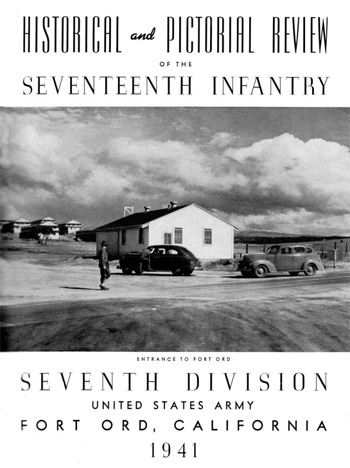
1941 Book with Historical & Pictorial Review of the 17th Infantry Regiment, 7th Infantry Division, activated at Fort Ord, Monterey, California. The 30th Field Hospital not only trained at Fort Ord, it also accompanied ATF # 9 to the Aleutians, and furthermore served together with the 17th Infantry Regiment in the Islands Chain.
Amphibious Training at Ford Ord, California, consisted of the use of landing nets, sea maneuvers on LCAs, LCVPs and LSTs, assault on beaches and the establishment and maintenance of beachheads. The 30th Field Hospital was eventually assigned to the 17th Infantry Regiment / 7th Infantry Division which it was to meet at Adak Island, Alaska (the Regiment arrived at Fort Ord, California, for amphibious training 15 January 1943 and departed San Francisco POE on 24 April 1943 to participate in the invasion of Attu Island on 11 May 1943 –ed).
On 2 July 1943 1st Lieutenant Bert Weinstein joined the Hospital. Several last minute changes were necessary because of physical deficiencies found in men transferred in at the last minute. On 4 July 1943 eighteen (18) Medical and Surgical Technicians were assigned to the 30th Field Hospital in lieu of the 18 ANC Nurses provided for as per T/O. Early July 1943 the unit’s strength stood at 18 Officers and 235 Enlisted Men. Finally on 5 July an advance loading detail was sent to the Port of Embarkation, San Francisco, California. The last high priority medical equipment was transported to the POE by special motor convoy. At 2300 hours, 10 July 1943, the 30th Field Hospital entrained at Fort Ord loaded down under the weight of fully packed rucksacks, firearms, and individual equipment and arrived at SFPOE at 0500 hours 11 July.
After final processing and roll call, the Hospital boarded the USS “Heywood”, APA-6, a US Navy amphibious attack transport (troop accommodation: 1278 men –ed) 11 July 1943 and lifted anchor at 1700 hours, after having been in training almost 10 months in the Zone of Interior. This was to be the unit’s first mission overseas.
Aleutian Islands:
Adak Island
The USS “Heywood” (Cdr: Captain Herbert B. Knowles –ed) attack transport sailed out into the Pacific Ocean on her way to Alaska and the Aleutian Islands with 6 other transports and 4 destroyers that acted as escorts. The personnel were told that the first destination was to be Adak Island in the Aleutians. The trip was uneventful except for a day or two of very heavy seas which induced quite considerable seasickness among the men.
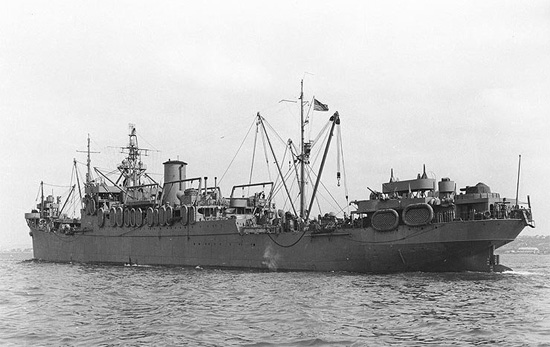
Picture of USS “Heywood”, APA-6, off San Pedro, California, in 1943. The Attack Transport carried both the 30th Field Hospital and the 17th Infantry Regiment to the Aleutian Islands in mid-July 1943.
On 23 July 1943 the convoy reached Adak Island and debarkation was started. Snow was still on the mountains nearby. The harbor was filled with ships of all descriptions. Battleships, cruisers, destroyers, LCTs, LSMs, LCIs, and LSTs were present in great numbers in addition to many transports. It was evident that a large Invasion Force was gathering as Adak was a beehive of activity. After debarkation and assembly, the 30th proceeded to its designated site located on top of a hill in the 17th Infantry Regimental area in order to set up enough tentage to quarter personnel, a kitchen, a supply tent, a dispensary, several latrines, and the unit’s headquarters. The stay on Adak Island would later be remembered mainly for the constant rain, fog, humidity, and the strong gusty winds which blew from several directions at the same time. Most of the time on the island was spent in getting familiar with the various Beach Combat Teams which each Hospital Platoon was scheduled to support, in checking supplies and equipment needed for the operation, and in general getting oriented to the climate, terrain and weather which was typical of all islands in the Aleutian chain.
Great Sitkin Island
On 1 August 1943, 7 Officers and 51 Enlisted Men representing all 3 Hospitalization Units (or Platoons) of the 30th Field Hospital left Adak on the SS “George Flavel”, XAP-78, for maneuvers on the island of Great Sitkin, twenty miles distant. The personnel landed in a mock amphibious assault and proceeded to the beach with individual equipment and enough medical supplies to set up a temporary Aid Station and do emergency surgery. The terrain on Great Sitkin was supposed to be similar to the beach and inland area on Kiska Island on which the 30th Field was to subsequently make its landing! After spending 6 days on the water and only a single day on the island everyone returned to Adak to start the final staging for the invasion of Kiska Island.
On 12 August 1943 Headquarters 30th Field Hospital + First Hospitalization Unit under command of Major James M. Marvil embarked on the SS “George Flavel”, a Liberty Ship, with the 1st Battalion of the 17th Infantry Regiment (the vessels “George Flavel” and “Heywood” carried 258 Officers, 9 Warrant Officers, and 5,661 Enlisted Men of the 1st Battalion to Kiska Island, and landed on Scarlet Beach # 10, 15 August 1943 –ed). Lt. Colonel Elmo R. Zumwalt and 1st Lieutenant Brehm were assigned to the USS “Heywood” together with Headquarters 17th Infantry Regiment, 7th Infantry Division. Major Leonard Winter and the Second Hospitalization Unit were assigned to the 2d Battalion of the 17th Infantry Regiment and boarded the USS “President Fillmore”, while Captain Gerald W. Hamilton and the Third Hospitalization Unit were assigned to the 3d Battalion of the 17th Infantry Regiment which embarked on the USS “Tjisadane”.
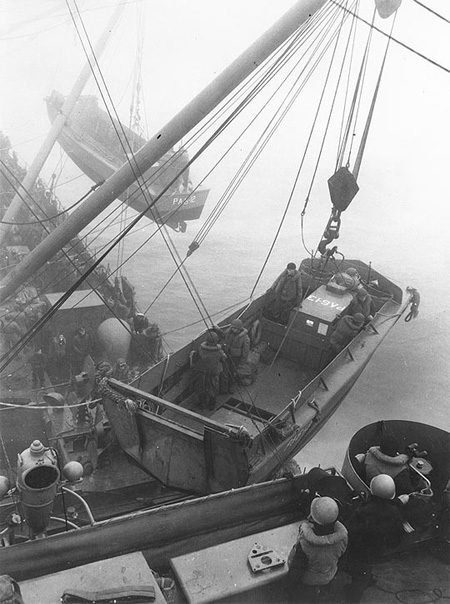
15 August 1943. USS “Heywood”, APA-6, lowers some its landing craft during the Kiska Island invasion.
First and Third Hospitalization Units (or Platoons) were to land on “Scarlet Beach”, a southern beachhead, while the Second Hospitalization Unit was part of the large TF which was slated to make a feint at Gertrude Cove while the initial landings were taking place on the opposite side of Kiska Island!
Kiska Island
The trip to Kiska Island was uneventful. The First Hospitalization Unit dropped anchor at about 0200 hours on 15 August 1943 off the southwest corner of the island and waited until approximately 0900 hours when the first troops were taken off the ship. About that time a minor fire broke out in the ship’s hold no. 3 after a jeep’s engine backfired, igniting spilled gasoline and setting fire to sleeping bags. This caused considerable anxiety making the troops to unload in a rather hasty manner. A destroyer sent a fire-fighting detail to help extinguish the blaze before serious damage was done and also took aboard the soldiers evacuating the ship. They landed on Scarlet Beach # 9 near Quisling Cove where due to the low tide they had to transfer to rubber boats in order to make the last hundred yards over the rocky shore.
The day was beautiful and there seemingly was no evidence of a Japanese presence. Due to the rocky nature of the treacherous shoreline, it was possible to land only one landing craft at a time. Luckily there was no enemy waiting to fire on the landing party.
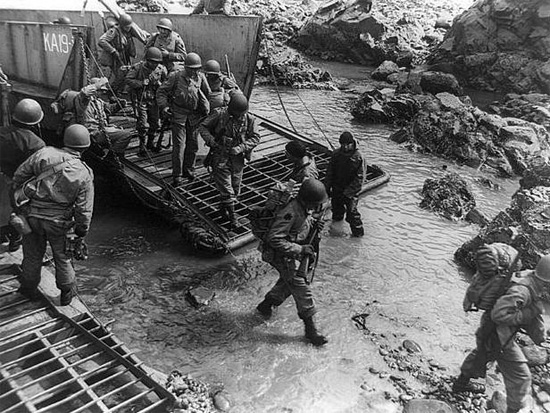
Infantry troops land on “Scarlet Beach”, Kiska Island …
Headquarters 30th Field Hospital and First Hospitalization Unit were the very first to be ashore and a spot was selected by the Combat Team Surgeon near a line of drift, about some fifty yards inland. Two (2) pyramidal tents and the equipment brought ashore on the backs of the men in rucksacks were set up and immediately, though limited, hospital care was made available. Casualties came in and were treated that same afternoon and the following night. Additional medical supplies and hospital equipment were secured from the ship (SS George Flavel –ed) by a detail of EM led by Major J. M. Marvil.
The Third Hospitalization Unit of the 30th and Third Platoon, 28th Field Hospital landed in the afternoon of 16 August 1943. This gave the unit a rather heterogeneous Field Hospital complex of 18 Officers and 235 Enlisted Men. By night the Hospital had admitted 40 bed patients. Continuous emergency medical service was provided to all troops on Scarlet Beach for approximately one whole month by the First Hospitalization Unit and Headquarters as the other two Platoons were dispatched on the opposite side of Kiska the fourth day after landing. From 15 August 1943 to 31 August 1943 inclusive, the Hospital maintained near Scarlet Beach treated 190 cases. Evacuation in all cases was to the ships waiting offshore. During this period there were no mortalities. In the early stages the longest period of hospitalization for any patient was 48 hours, depending on the availability of landing crafts and ships. The longest period of time for hospitalization was 15 days (patient treated for an appendectomy –ed).
The Second Hospitalization Unit engaged in the Gertrude Cove feint, was never landed, and returned to Adak Island where it bivouacked until 31 August 1943. On that day they were ordered back to Kiska.
A total of four Field Hospitals served on the island. They were: the 6th Field Hospital – 28th Field Hospital – 29th Field Hospital and the 30th Field Hospital.
On 7 September 1943, ALL units assigned to the Hospital joined at Trout Lagoon, a site occupied by the Hospital until the date of departure from the island on 12 February 1944. For its participation in the assault landing on Kiska Island a Commendation was received by the 30th Field Hospital from the Task Force # 9 Surgeon. Also a miniature bronze star was authorized to be worn later by each man in the unit for his part in the Battle of the Aleutians by authority of General Order # 75, War Department, 1943. In addition to the above the 30th Field was entitled to battle honors with the prescribed Battle Streamer by authority of General Order # 83, Headquarters, Alaskan Department, dated 22 April 1944.
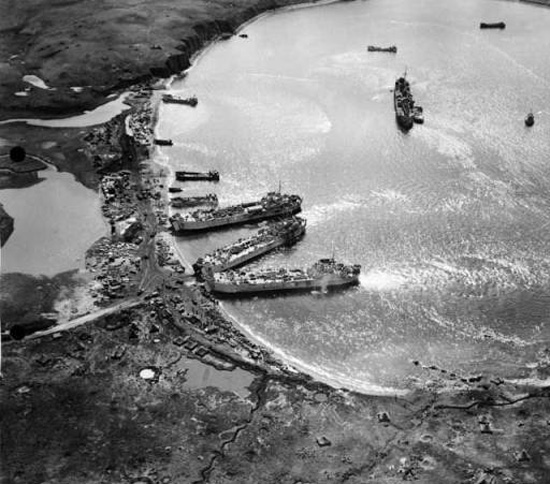
Aerial view. Headquarters 30th Field Hospital and supply ships concentrate at Gertrude Cove, Kiska Island.
New Year’s day – 1 January 1944, found the 30th Field Hospital celebrating in Zephyr Valley overlooking Trout Lagoon. A fine turkey dinner with all the trimmings was enjoyed by all. Personnel used ski equipment to good advantage on this day, as on other days, with plenty of snow. This equipment was given to the unit through compliments of the Special Service Officer.
Although the occupation of Kiska Island was achieved without enemy opposition, it nevertheless was conducted under combat conditions until the landing was well underway. The lack of contact with enemy forces was unexpected, but it was not wholly surprising. Intelligence had suggested that the Japanese might withdraw to prepared positions on the high ground back of the beaches as they had done at Attu. Consequently, the landings scheduled for the next morning were not canceled or altered. Aerial reconnaissance, which might have revealed the true state of affairs, was hampered by adverse weather. The anticlimactic character of the invasion of Kiska, while disappointing because American/Canadian Forces, well-prepared, were prevented from coming to grips with the enemy, was compensated by lives saved and lessons learned under severe conditions which were nearly those of combat.
Stay in the Aleutian Islands – 30th Field Hospital
23 July 1943 > 11 February 1944
Return to Zone of Interior:
On 12 February 1944 the organization departed Kiska Island for the Zone of Interior, arriving in Seattle, Washington, on 20 February. Apart for very rough seas and high winds the first two days the trip was really uneventful. This time the 30th Field traveled on board the USS “Grant” (Cdr: Captain Charles L. Hutton –ed).

Top: Group picture illustrating staff and personnel of the 30th Field Hospital.
Bottom: Small group of female personnel of the 30th Field Hospital, such as Miss Katherine H. Murdoch, ARC (standing), Second Lieutenants Ada Timmer, Mary C. Beggs, Dorothy E. Beavers, Julia A. Davis (back row), and Moore, Smith, Taberner (front row), all ANC Officers.
After spending five days at Fort Lawton, Seattle, Washington (Army Post spread over 1,100 acres, the second largest Port of Embarkation for troops and supplies destined for the Pacific Theater during World War Two –ed), the unit entrained for another station, namely Camp Bowie, Brownwood, Texas (Armored division Camp: acreage: 116,264, troop capacity 2,237 Officers & 43,247 Enlisted Men –ed) where it arrived 29 February 1944. Commencing 6 March a full twenty-day furlough was issued to the bulk of the staff and personnel, including Officers and Enlisted Men. After furloughs and leaves were completed the 30th settled down to another Training Program as per the Medical Training Office, Camp Bowie, Texas.
New orders had meanwhile been received on 1 March 1944 instructing the organization to prepare for movement (POM) to a Port of Embarkation for subsequent shipment to a new overseas destination. Consequently the unit entrained for Camp Kilmer, Stelton, New Jersey (Staging Area for New York Port of Embarkation: acreage 1,815, troop capacity 2,074 Officers & 35,386 Enlisted Men –ed), with about 15% new Enlisted Men, 50% new Officers and with excellent morale.
Commanding Officers – Second Hospitalization Unit, 30th Field Hospital
Major Leonard Winters > February 1943
Major Francis G. Pipkin
Captain Walter H. Watson > 1 September 1944
Major Stephen W. Ondash > 23 September 1944
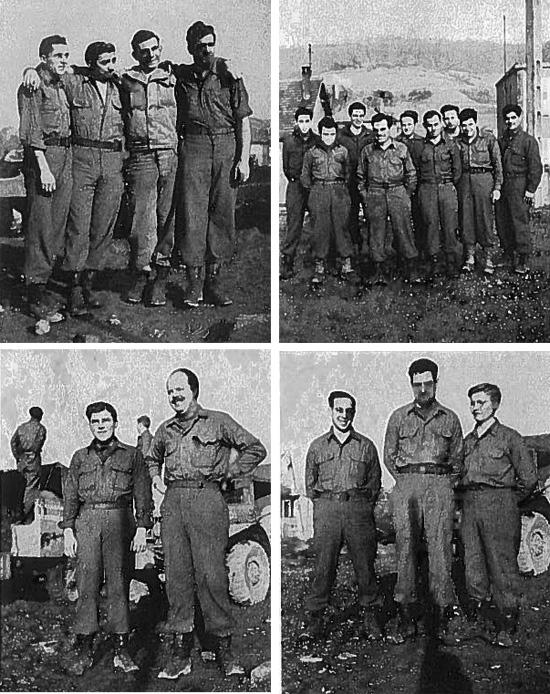
Random illustrations showing some of the different sections, organic subunits of the 30th Field Hospital, such as the kitchen, surgery, x-ray, supply, laboratory, pharmacy, and the dental department.
Preparation for Overseas Movement:
On 30 April 1944, the 30th Field Hospital was alerted and on 2 May 1944 the entire unit boarded the USS “General William Mitchell”, APA-114, lifting anchor the next day.
The overseas voyage as a whole was calm, pleasant, and uneventful, with the foreseen routine drills and exercises on board. On 14 May 1944, the ship arrived at Greenock, Scotland, where the troops were happy to debark. After assembly and roll call, the entire organization made for the pier’s railhead where they started their journey for Nuneaton, Warwickshire, England (Nuneaton situated some 9 miles north of Coventry held a number of munitions plants which suffered heavily from German bombings during the war –ed).
United Kingdom:
Effective 15 May 1944 the organization was assigned to the Third United States Army (TUSA) per United States Army Troop Assignment Order # 64, ETOUSA, dated 12 May 1944. The entire unit was billeted in private homes and the local Home Guard Drill Field turned over to the unit to set up a camp. Recreational facilities consisted of local theaters, public houses, and an inter-hospitalization unit athletic league played on the former large drill field. A colorful baseball game was played by members of the 30th for benefit of a local charity organization thereby attracting a large civilian audience. This game was sponsored by the local Home Guard unit and was the first American baseball game witnessed by the large crowd of English spectators. It proved a huge success and was enjoyed immensely both by the crowd and the participants. A large dance hall adjacent to the drill field afforded many a pleasant evening to those attending. Periodically, groups of Enlisted Men made tours of the English countryside to visit historic spots and other places of interest. Among the various places were trips to Stratford-on-Avon, Kennilworth Castle, Astley Castle, and Coventry.
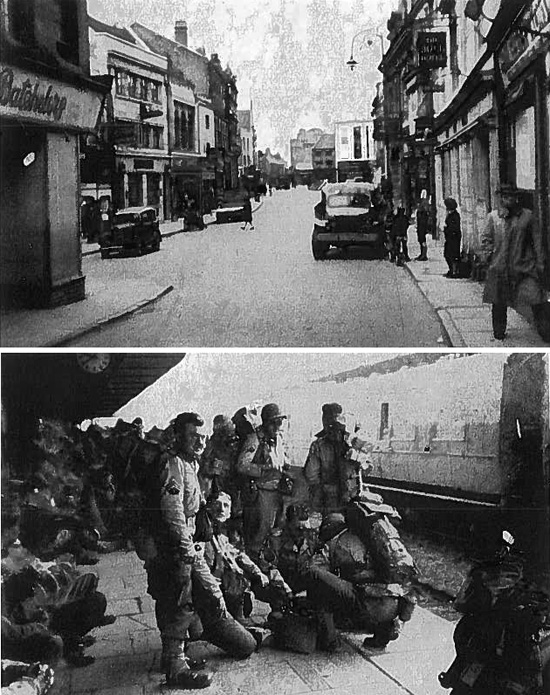
Top: May 1944. Queens Road, Nuneaton, England. One of the stations where the 30th Field Hospital stayed and trained from 15 May to 6 July 1944.
Bottom: July 1944, group of personnel of the 30th Field Hospital at Nuneaton railway station waiting to entrain for the Concentration Area at Tisbury.
On 6 July 1944 the organization received movement orders transferring it to a Concentration Area in Tisbury, Wiltshire (first US troops arrived in the area in August of 1942, at one time 15 American Divisions and other units were stationed in towns and villages across Wiltshire until January 1945 –ed). The troops usually underwent training on Salisbury Plain before leaving for the Continent to take part in the D-Day Invasion and further battles.
On 12 July 1944 the first 7 Nurses were assigned to the 30th Field (the unit had in fact never received any ANC personnel since being activated –ed) all coming from the 67th General Hospital. The stay at Fonthill-Gifford Camp (a Parish of Tisbury), situated on a lovely green English hillside was a very pleasant one and seemed to put everyone in the proper state of mind in preparation for a forthcoming move to the Continent … The Hospital entrained for the Marshalling Area with the remaining 17 ANC Officers arriving to put the organization at its authorized strength. Two (2) American Red Cross workers were also assigned.
On 22 July 1944 the unit embarked on an old British vessel, named SS “Longford”, and spent the whole night in the English Channel.
Stay in the United Kingdom – 30th Field Hospital
14 May 1944 > 21 July 1944
France:
After spending the night of 22 July 1944 at anchor in the English Channel, the “Longford” proceeded the following day in convoy to debark on the shores of France.
The SS “Longford” with the 30th Field Hospital on board reached Utah Beach on the afternoon of 23 July 1944 debarking its passengers on the shores. After securing some motor transportation, the following 2 days were spent in setting up a bivouac area in a hedged-in cow pasture, about 1 mile north of Les Moitiers-d’Allonne, Basse-Normandie, in a liveable condition. Being in a recently-liberated combat area, everyone was rather preoccupied with watching the endless waves of Allied bombers flying directly overhead on their way to support ground troops breaking out of the Normandy Beachhead in summer. The Battle of Normandy was almost over; the Battle of Northern France was on.

Top: May-June 1944. Scenes illustrating ongoing surgical activities in the operating room of the 30th Field Hospital. From L to R: Major Stephen W. Ondash, Captain Bernice J. Moore.
Bottom: From L to R: Major Wilfred C. Moore, and Major Stone.
The 30th Field remained in bivouac in Les Moitiers-d’Allonne and later in Louvigné-de-Bais, Brittany, until 14 August, when the organization was split.
The First Hospitalization Unit was separated from its parent organization in order to support the 8th Infantry Division; the Second Hospitalization Unit became operational on 17 August 1944 and went to support the 7th Armored Division, attached to XX Corps, at Chartres. The second Hospitalization Unit (or Platoon) arrived at approximately 1300 hours on the outskirts of the city, 13 miles ahead of the Clearing Station, while the 7th Armored Division was engaged in cleaning out the remnants of a stubborn enemy force. At 1630 eight enemy 88-mm shells landed merely two hundred yards from the area and were getting closer with each shell. The area was therefore ordered evacuated until the situation would become secure. At this point the unit became acquainted with the 4th Auxiliary Surgical Group, 3 Teams of which were attached to relieve the unit surgeons who had been working steadily for 40 hours without a single break!
4th Auxiliary Surgical Group Attachments – 30th Field Hospital
Team No. 8 > Captain Yudiky, Captain Elson, Captain Moore, Captain Young, 1st Lieutenant Rundle, Sergeant Martin, Corporal Bauman
Team No. 20 > Major Stone, Major Moore, Captain Futch, 1st Lieutenant Goldstein, Corporal Matis, Corporal Heucheroth
Team No. 123 > Captain Weigler, 1st Lieutenant Wocky, 1st Lieutenant Riley, Corporal Doire, Corporal Cappello
From Chartres the Second Hospitalization Unit moved forward once again in support of the 7th Armored Division, this time just west of Verdun, at Rampont, in Lorraine, where it remained to provide medical support to the division from 3 September to 27 September 1944, on which date it changed its support to the 90th Infantry Division. Due to the rapid changes in the tactical situation, the organization changed locations no less than five times between 13 and 27 September, four of these moves being accomplished in a period of only six days and the complete 100-bed Hospital being set up three of these times overnight.
On 22 September 1944, Major Stephen W. Ondash took over command from Captain Walter H. Watson.

Top: August 1944. Bivouac at Barneville, Normandy. The stage in front of one of the ward tents was set up for the “Baron Elliott Orchestra” (35th Special Services Company) which brought the show ‘Broadway in Khaki” while touring the ETO.
Bottom: November 1944. Rombas, Lorraine. One of the buildings temporarily occupied by the 30th Field Hospital, on its way to Germany.
The Second Hospitalization Unit continued to support the 90th Infantry Division at Jarny (27 September to 25 October 1944), Giraumont (26 October to 6 November 1944), both in the Lorraine region. At this time the 95th Infantry Division relieved the “Tough Ombres”. The unit remained in position but changed its support to the newly-arrived 95th Infantry Division. On 17 November a change in location took place whereby the Second Hospitalization Unit left Giraumont and moved further on to Rombas, and then to Bouzonville on 12 December 1944. On the night of 13-14 December, Second Platoon now joined by Headquarters 30th Field Hospital came under heavy enemy shelling for the second time since becoming operational. The artillery barrage commenced at 2200 hours, 13 December, and continued onto the following day. Shells fell in or about the hospital building, causing considerable damage to the third floor and caving in this section of the building including the first floor. One (1) man belonging to an Ordnance unit was killed outright and 8 other men were buried in the debris receiving relatively minor injuries. During the shelling an operation was in progress in the surgery section and even though the part of the building destroyed was located not more than fifteen yards from the OR, the work went on uninterrupted. The remainder of the Hospital staff and personnel remained in an air raid shelter during the bombardment. Four (4) “Purple Hearts” were awarded to members of the Second Hospitalization Unit. The following day the position and damaged building were evacuated and the unit established in the field at Freistroff, Lorraine region, where it was to remain until 23 December 1944. The same day another change of station occurred which sent the unit to Veckring, still in the Lorraine region of France. At this point the Platoon was supporting the 90th Infantry Division again.
Stay in France – 30th Field Hospital
23 July 1944 > 25 February 1945
1945 – the start of the New Year found the 30th Field Hospital still at Veckring and supporting the same Division. At the time the “Tough Ombres” were holding the southern salient during the siege of Bastogne. On 8 January 1945, while still stationed at Veckring, the 90th Infantry Division was replaced in this area by the 94th Infantry Division.
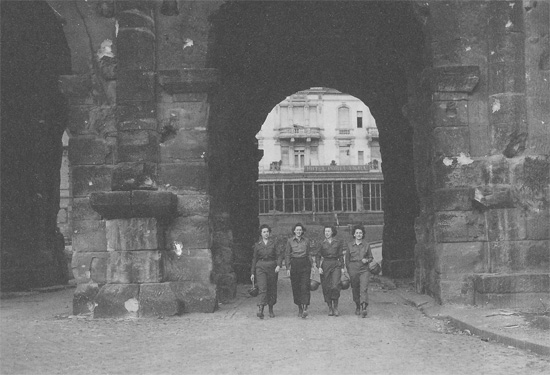
18 March 1945. Some 30th Field Hospital Nurses walk through the “Black Gate” (Roman Porta Nigra monument) while visiting Trier, Germany.
Germany:
On 26 February 1945 a portion of the Hospital departed for Saarburg, in the Rhineland-Palatinate region, Germany, to set up in a civilian hospital. At this point, the 30th experienced its heaviest casualty traffic in its history. On 19 March the unit moved to Baumholder, and from there it went on to Carlsberg, which it reached on 23 March 1945. The next move would take the Hospital to Langensalza, after which it crossed the Rhine River. At this point enemy activity was brisk and bombing and strafing of the hospital area frequent. The Germans were now defending their homeland, being attacked both from the West and the East. From Langensalza the unit’s next destination was Zeitz. However before entering the city proper it was necessary to remain on the outskirts until the infantry and armor had cleared the remaining enemy from it. From Zeitz the organization moved further to Rochlitz on 16 April 1945, also located in Saxony, Germany, now following in the tracks of the 6th Armored Division. At the time the latter division represented the deepest Allied advance into Germany! Only staying for a short while in Rochlitz, the 30th then traveled to Schniegling, in Bavaria (near Nürnberg –ed) where it arrived 23 April. While at Schniegling and in bivouac, there was plenty of opportunity to visit the Sportplatz and Stadion where Adolf Hitler held many of his speeches to the Nazi Party during the many rallies.
Stay in Germany – 30th Field Hospital
26 February 1945 > 7 May 1945
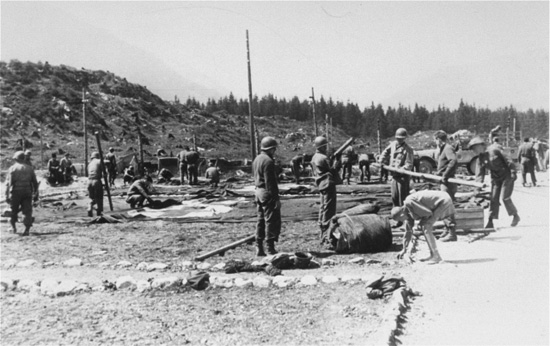
8-10 May 1945. 30th Field Hospital personnel set up their temporary hospital at KZ-Ebensee, shortly following the Concentration Camp’s liberation.
Austria:
29 April 1945 found the Second Hospitalization Unit supporting the 80th Infantry Division in Pfaffenberg, still in Bavaria, Germany. Although 7 May 1945 marked the end of the war in Europe (V-E Day > 8 May 1945 –ed) there was, ironically enough, not sufficient time to celebrate as 2½-ton trucks arrived to carry the personnel to KZ-Ebensee, Austria (liberated by elements of the 3d Cavalry Group around noon 6 May 1945 –ed) where they were to join the other elements of the 30th Field Hospital charged with camp sanitation of recently-liberated Displaced Persons and Political Prisoners near that town and treatment of thousands of people ravaged with disease and malnutrition (approximately 16,000 starving inmates were discovered after liberation –ed). The unit rolled through the town of Ebensee on 10 May to discover the horror of the Concentration Camp. The place was a death camp for KZ-Mauthausen, the largest concentration Camp in Austria where prisoners came in to work excavating in the mountains. Most of the inmates were worked to death and resembled walking skeletons, and although the medical staff were more or less accustomed to illness, suffering, and even death, they were not only shocked but physically sick after their first view of the camp survivors. Most of the ex-inmates, emaciated survivors of the camp’s inhuman regime, were still crammed in disease-ridden overcrowded barracks. Reports were to describe the establishment of three hospitalization units at the site of KZ-Ebensee; the setup of a Typhus Diagnosis Center in Traun; and the treatment of the former camp inmates up to 23 June 1945, after which all remaining cases were transferred to an Austrian civilian hospital in Bad Ischl, Austria.
Stay in Austria – 30th Field Hospital
10 May 1945 > 28 June 1945
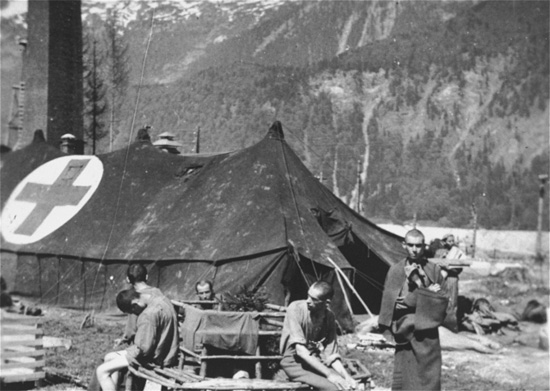
Ex-inmates of KZ-Ebensee relax in the open near one of the tents set up by the 30th Field Hospital. The survivors were first deloused and showered, after which followed triage and initial medical treatment.
The Second Hospitalization Unit of the 30th Field Hospital made its late move on 28 June 1945 departing Ebensee, Austria, for Bad Wörishofen, slightly east of Mindelheim, Germany, to support the 80th Infantry Division once more. As usual, living quarters proved excellent (buildings), with many conveniences added to make living conditions very comfortable.
Finale:
On 1 July 1945 word came from Headquarters that all Enlisted Men with 85 or more points would be immediately transferred out of the 30th Field Hospital. Based on the latest Readjustment and Redeployment Regulations the news was more than welcome to all concerned in as much as it would start the men on their way home. However, the first 18 EM scheduled to leave were far from happy because this would mean parting with many good friends and combat buddies made while serving with the Hospital. The lowest score (based on the ASR Points system –ed) in the Second Hospitalization Unit was 74, consequently it wouldn’t be long before an entirely NEW 30th Field Hospital was organized with replacements. With the prospects of a much lower critical score being established in the near future (it was indeed gradually lowered –ed), many of the unit’s personnel would become eligible for discharge!
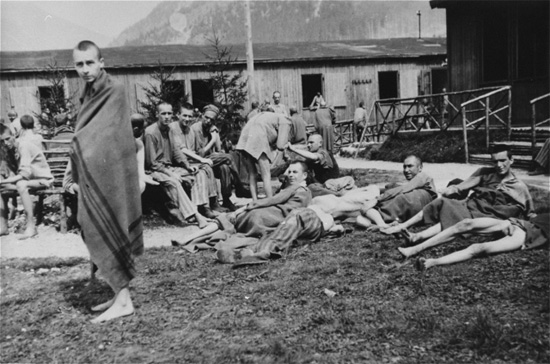
10 May 1945. KZ-Ebensee survivors gather together near one of the camp’s installations after having enjoyed a shower (portable shower unit) installed by some engineers at the liberated camp’s site.
Units Receiving Medical Support from the 30th Field Hospital
Kiska Task Force
5th Infantry Division
7th Infantry Division
8th Infantry Division
26th Infantry Division
80th Infantry Division
90th Infantry Division
94th Infantry Division
95th Infantry Division
6th Armored Division
7th Armored Division
10th Armored Division
XX Corps
Third United States Army
Roster (incomplete):
| Officers | |
| Colonel Herbert H. Kerr (Second CO, 30th Fld Hosp) | Captain Friedman |
| Lt. Colonel George S. Bozalis (Third CO, 30th Fld Hosp) | Captain Glendening |
| Lt. Colonel Francis R. Sandford (Fourth CO, 30th Fld Hosp) | Captain William V. McDermott |
| Lt. Colonel Elmo R. Zumwalt (First CO, 30th Fld Hosp) | Captain Bernice J. Moore |
| Major Edgar Fonde | Captain Nystrum |
| Major Hamilton | Captain John B. Porter |
| Major James E. Marvil | Captain Walter H. Watson (Third CO, 2d Hosp Unit) |
| Major Wilfred C. Moore | 1st Lieutenant Brehm |
| Major Stephen W. Ondash (Fourth CO, 2d Hosp Unit) | 1st Lieutenant Jacquet |
| Major Francis G. Pipkin (Second CO, 2d Hosp Unit) | 1st Lieutenant Shaver |
| Major Stone | 1st Lieutenant Waye |
| Major Leonard Winter (First CO, 2d Hosp Unit) | 1st Lieutenant Bert Weinstein |
| Captain Bolkens | Chaplain O’Hern |
| Captain Russell J. Catalano | |
| ANC Officers | |
| Dorothy E. Beavers | Lucille H. Smith |
| Mary Catherine Beggs | Taberner |
| Julia A. Davis | Ada Timmer |
| Moore |

12 May 1945. KZ-Ebensee survivors are evacuated to the 139th Evacuation Hospital for further medical care.
| ARC Staff Worker | |
| Miss Katherine H. Murdoch | |
| Enlisted Men | |
| Albertine (Pvt) | Lingley (Pfc) |
| Deward J. Allen | Maynard F. Lombard |
| James L. Baker | William J. Lowry |
| Forest L. Balderson, Jr. | Joseph J. Lulf |
| Kenneth M. Banks | Lynch (Pvt) |
| Francis P. Barber (Pfc) | Chester Maleski |
| Francis O. Barts | Gordon T. McAllister |
| Leland G. Bolton | McCormick (Pfc) |
| John M. Bourgault (Pfc) | McKiethan (Cpl) |
| Robert M. Bowers | Theodore H. Meler |
| Charles R. Brandfass (Tec 3) | Robert H. Mimiaga |
| William P. Campbell | Moore (Cpl) |
| Frank Castino | John J. Mullen |
| DeWayne L. Charfe | John R. Nielsen |
| James D. Clark | John Ofer |
| Leo M. Cloward (Pfc) | Padula (Pvt) |
| James L. Davis | William P. Paukovits |
| George DeJong | Oral A. Rice |
| Divona (Pvt) | Ronald E. Riemer |
| Arthur Fensky | Cecil A. Robbins |
| Lester P. Finnegan | Hebert Rosenthal |
| Louis Ganz | George Sadlon |
| Hackworth | Harvey W. Schroeder |
| Haywood R. Hancock | Nathan Shapiro |
| Russell M. Heldbrink | Thompson (Cpl) |
| Herring (Pvt) | Clarence Trower |
| Paul D. Hill | Trudel (Pfc) |
| Dan R. Hornbeck | George G. Vassar |
| Robert L. Hunter | Vilmer (Pfc) |
| Joe Janosik | John, E. Watson |
| Ralph A. Johnson | Robert E. Weaver |
| Harry D. Jones | Robert C. Welsh, Jr. |
| Charlie R. Joyner | Bernard A. Widen |
| Rubin Kremberg | Wilhite (Cpl) |
| Labachotte (Pfc) | William J. Wright |
| John F. Lazor | Zito (Pfc) |
Campaign Awards – 30th Field Hospital
Aleutian Islands
Northern France
Ardennes-Alsace
Central Europe
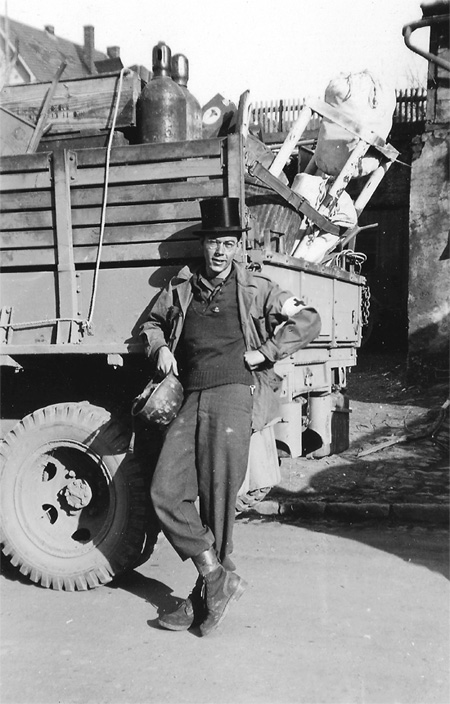
Technician 3d Grade Charles R. Brandfass, Second Hospitalization Unit, 30th Field Hospital. Courtesy Robert Brandfass.
Our sincere thanks must go to Robert Brandfass, son of Tec 3 Charles R. Brandfass (ASN:15324088) who served with the Second Hospitalization Unit, 30th Field Hospital from 1942 to 1945. Robert generously offered us a copy of a booklet distributed to the unit’s personnel at the end of the war. Without his help the authors would not have been able to edit this concise Unit History. The MRC Staff are still looking for a complete Personnel Roster of the unit and its date of return from the European Theater to the Zone of Interior. All information welcome!
